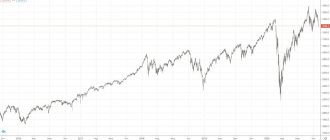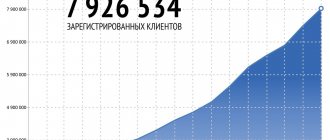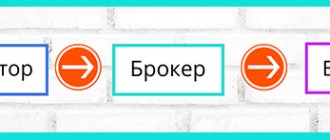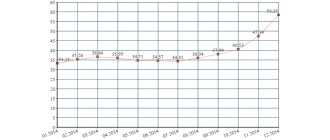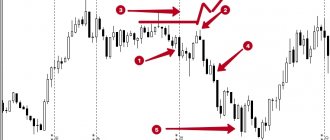Macroeconomic indicators have a significant impact on the market, shaping investor sentiment. To level out strong fluctuations on the stock exchange, there are indicators that lead statistics. They reflect the current situation in the industry, the economy as a whole and set expectations for future statistical reports. We are talking about PMI business activity indices related to US macroeconomic indicators.
The PMI business activity index (from the English Purchasing Managers' Index) is an indicator of changes in key indicators of enterprises, in the form of a scale from 0 to 100%, calculated based on surveys of purchasing managers. The report reflects the state of industry and service enterprises. The calculation methodology is based on surveys of supply management specialists or supply managers from various sectors of the economy, where they are asked to compare current business performance with previous periods.
The calculation is carried out on the basis of questionnaires. Managers are asked to rate “worse,” “better,” or “no change” on the following performance indicators of their company:
- new orders (New Orders);
- production volumes (Production);
- Employment;
- supplies of components (Supplier Deliveries);
- inventories;
- Customers' Inventories;
- prices (Prices);
- backlog of orders (Backlog of Orders);
- new export orders (New Export Orders);
- imports.
The opinions of these specialists allow us to see the changes taking place in the economy, since they are directly related to production and see the dynamics of production volumes.
What is the business activity index
PMI is an index of non-governmental statistics taken into account to determine demand, efficiency of inventory and labor management.
The PMI business activity indicator is calculated in different countries and includes several components:
- New orders are the main component of the index. It is known that it is the efficiency of the purchasing manager that largely ensures the business reputation of the company. Interruptions in supplies negatively affect the rating among potential buyers, and an excessive amount of purchased goods leads to its damage or obsolescence, loss of funds, and waste of material and human resources.
- Employment is a key component for the labor market. The optimal number of employees employed in a certain field of activity is the result of the competent work of a recruitment manager.
- Purchasing prices are an indicator reflecting changes in the cost of goods, work or services. An increase in this component indicates an increase in the level of inflation, and a decrease in it indicates a decrease in interest on loans, which are often used to purchase raw materials, materials and equipment used in the production process.
- Import and export – volume of supplies.
- Inventory is a component that shows changes in commodity or raw material inventories in warehouses. Maintaining optimal inventory levels is important for several factors, namely:
- satisfying consumer demand;
- wise spending of funds;
- financial reporting indicators.
Next, let's look at what types of PMI business activity index there are.
Convenient project standardization
To ensure that professional project managers in different countries understand each other, the authors of the Guide standardize elements in all relevant thematic areas of knowledge. That is, they formalize project management in the field of integration, content, timing, cost, quality, human resources, communications, risks, procurement, and determine stakeholder management formats.
Each area further describes the individual processes that the project manager performs. The process-oriented approach makes it possible to establish an algorithm for choosing the most suitable design model for your business, which in this sense is fundamentally different from the functional management structure.
The functional structure, still common in our country, presupposes the presence of a direct supervisor for each employee and unites personnel by specialization (by department). The project structure involves the unification of workers from different departments and their subordination to the project supervisor. Such teams form their own divisions, and team members leave the subordination of the head of a specialized department for the duration of projects. If the project is very large-scale and complex, then the team is assembled specifically for it.
Matrix structures are now becoming popular, in which team members do not leave their functional departments for the duration of the project, reporting to the functional manager on one hierarchical line, and the project manager on the other. In this case, the strong and weak matrices are separated. In the first case, project instructions are transmitted through the functional manager, and the powers of the project manager in this case are weakened. In the second case, employees of functional departments are not removed from their composition, but are seconded to the project under the leadership of the project manager.
Depending on the complexity of the project and its routine, one or another choice of model may be preferable:
- If the project is routine in nature, then it is not necessary to rebuild the format - the functional model also works effectively.
- If the uncertainty of the work is average, then a weak matrix is more effective.
- If uncertainty is high, and deadlines are critical and the importance is high enough, then a strong matrix or project structure is used.
In general, there is a general relationship: the transition from a functional model through weak and strong matrices to a project model correlates with the transition from routine, not very important and urgent work using a small number of performers to urgent, important, complex work that requires the involvement of a large number of human resources .
Types of PMI
PMI indicators come in two types and are calculated for each economic sector separately:
- PMI indicator for industry (PMI Manufacturing).
- PMI for the service sector (PMI Service).
Sometimes the value of the indicator for the non-production sector is also calculated separately, but in most cases all non-production activities are equated to the service sector.
PMI is a value calculated as a percentage. A value below 50 indicates an increase in business activity, and a value below 50 indicates a decrease. In addition, there are other control values:
- over 60 – possible increase in rates by the Fed, ECB, capital outflow;
- from 45 to 50 – slow economic growth;
- 42-45 – economic stagnation, it is advisable to transfer part of the assets to protective ones;
- 30-42 – negative forecast, high probability of recession;
- below 30 – recession.
The value of the indicator can also take a negative value.
Let's look at examples for individual countries.
Over the past 3 years, the Russian PMI manufacturing activity index showed the highest value - 52.8, the lowest - 45.6. If you analyze the PMI chart, you can note a certain cyclicity: when the level of 50 is exceeded, the maximum index value is reached after 6-7 months, then a gradual decrease is observed.
In Russia, the PMI index is an indicator that largely depends on energy prices. As for other countries, for the Russian Federation a fall in the PMI index below 50 indicates that the national currency exchange rate is losing its stability.
Recently, great attention has been paid to the development of the digital economy of the Russian Federation. As part of increasing the level of digitalization of individual economic sectors, the national index of development of the digital economy of the Russian Federation is used. This indicator is calculated using the following parameters:
- digital technologies in business and social sphere;
- digital economy personnel;
- research and development in the field of information technology;
- Information Security;
- digital technologies for the population, etc.
Project Management Institute
The Project Management Institute (PMI) was created in 1969 as a non-profit organization of the professional management community. Among the founders were J. Gordon Davis, John King, Eric Janet, Susan Gallagher, Ned Engman, James Steder. And, starting from the 80s, the history of the Institute began to develop quite quickly.
- 1981 The Institute acquired the status of a business league.
- 1984 – the first certification exam was held.
- 1986 - The first edition of PMBoK (stands for Project Management Body Of Knowledge) is published - a guide that allows you to streamline project activities. Subsequently, an update to the Guide was released on average every 4 years. The fifth edition of 2013 contains about 600 pages, of which about 40 pages are taken up by the Project Management Standard.
- 1991 - The standardized PMBoK Guide format, known as the PMI standard, is recognized as an American National Standard (ANS) (status secured by ANSI - American Standards Institute).
- 1994 – the first edition of the Standard was published.
- 1996 - due to the rapid growth in the number of members, the second edition was published, after which the third edition of PMBoK Guide 2000 appeared, four years later - already under the name PMBoK Guide Third Edition.
- 1998 – the Russian branch of the Institute was opened in Moscow, which now unites about five thousand specialists.
- 2008 (on the last day of the year) a version of the “Manual” was released, which differed significantly from the previous ones in its recommendations for structuring management (the so-called PMI methodology).
The range of interests of PMI representatives is not limited to any particular industry segment, affecting almost all areas of the economy: from mechanical engineering and aerospace to pharmaceuticals and information technology. Based on the “Manual,” which contains standardized templates for methodologies, specialists develop and implement the methodology in most businesses.
To be able to lead a project as an Institute specialist, you need to pass exams and earn a certificate at one of two main levels or three additional levels:
- PMP level – management professional. PMI PMP certification speaks about the specialist’s theoretical knowledge, mandatory practical experience in project implementation (5 years of project management) and the specialist’s acceptance of the Code of Ethics. PMP candidates' experience includes managing cross-functional teams on projects delivered within budget, schedule and scope.
- The CAPM level gives the right to work as a project management assistant. This certification appeared later than the main one and is not yet in demand in Russia as widely as PMP. As an assistant CAPM specialist:
- defines management plans,
- offers improvements to increase productivity,
- adjusts requirements, tolerances and restrictions,
- Provides administrative support.
- At three additional levels, the PgMP designation becomes a program management professional, the PMI-SP designation is a certified project schedule management professional, and the PMI-RPM designation is a risk management certification.
The PMP exam takes the form of a test and is conducted in international Prometric centers located around the world (the Institute has branches in 185 countries).
How is PMI calculated?
The formula for calculating the indicator is extremely simple and looks like this: PMI=(P1*1)+(P2*0.5)+(P3*0), where: P1 – the proportion of survey participants with positive ratings; P2 – proportion of participants who did not notice changes; P2 – the proportion of participants with negative ratings.
In this case, the shares of respondents are distributed in percentage terms:
- orders – 30%;
- employment – 20%;
- production cost (purchase prices) – 25%;
- deliveries – 15%;
- reserves – 10%.
The respondents' answers are classified as follows:
- “yes” (positive assessment);
- “no” (negative assessment);
- "without changes".
Detailed answers and explanations are not required.
History of the indicator
| date | Importance | Previous | Forecast | Fact |
| 2 November 2021, 18:00 | ||||
| 1 October 2021, 17:00 | 56.0 | 56.0 | 55.4 | |
| 1 September 2021, 17:00 | 54.2 | 54.6 | 56.0 | |
| 3 August 2021, 17:00 | 52.6 | 53.6 | 54.2 | |
| 1 July 2021, 17:00 | 43.1 | 49.5 | 52.6 | |
| 1 June 2021, 17:00 | 41.5 | 43.5 | 43.1 | |
| 1 May 2021, 17:00 | 49.1 | 36.7 | 41.5 | |
| 1 April 2021, 17:00 | ||||
| 2 March 2021, 18:00 | 50.9 | 50.5 | 50.1 | |
| 3 February 2021, 18:00 | 47.2 | 48.5 | 50.9 |
What does the PMI index affect?
PMI is an indicator of considerable importance in the economy. Its value affects the following indicators:
- The exchange rate of the national currency (with index values below 50, the rate falls, above 50, the rate rises).
- Securities quotes. Investment PMI is one way to evaluate the performance of investments in shares of individual manufacturing companies and government bonds. When the index is below 45, most investors try to get rid of securities, which sometimes leads to panic in the stock market.
- The magnitude and rate of growth or decline of GDP.
Main elements of the test program and methodology
The test program and methodology includes the following mandatory sections: - general provisions (name and purpose of the research object; purpose of testing; conditions for providing the object for testing; procedure for interaction between the contractor and the customer); — general requirements for test conditions, conduct and provision of tests (place and means of testing, their list; personnel preparing and conducting tests; conditions for testing and preparing the product for testing); — safety requirements (during the preparation of the facility, testing, completion of tests); — test program (test indicators and permissible measurement values are determined); — test modes (test order, restrictions in test modes, conditions for interruption/cancellation/termination of tests); — test methods (methods, techniques for conducting research, deducing results); — reporting (documents drawn up based on test results, their content, purpose, shelf life and recipients); - additional information (applications, etc.) The test program and methodology as a separate document must be drawn up for each type of product individually, since production products are different in their parameters and, therefore, the methods and methods for testing them must also be different.
You can get answers to all questions about the program and test methods simply or by filling out the form below.
Ask your question now
Test program and methodology (TPM) is a technical document that formalizes the product testing stage and is compiled for an automated program (ACS) or system. The document is intended to identify parameters that ensure the determination of the causes of failure, indicators of system quality, its compliance with various requirements, verification and obtaining design solutions, and also characterize the duration and period of testing.
PMI directly determines the reliability of a system or subsystem, its compliance with the specified requirements and the expected level of reliability. The program is compiled on the basis of document RD 50-34.698-90 and it specifies all the checks that determine the effectiveness of this design solution.
A typical test program includes sections:
Test object. Here the scope of application, name and other information from the technical specifications that relate to the program under test are indicated.
Purpose of testing. The main purpose is to test the product and verify the characteristics of the program. In fact, the purpose of the test is to deliver the project to the customer.
General provisions. The section includes the basis for testing, duration and location, a list of required documents and participating organizations are established.
Scope of testing. It describes the stages and modes of testing, qualitative/quantitative parameters, as well as a list of work that should be carried out based on the test results.
Test facilities. Description of all hardware and software used to conduct the test.
Test methods. Test methods and techniques that can be applied to the test object are indicated.
Economic essence of business activity
Business activity is a concept that determines the efficiency of an enterprise, economic sector, or the country’s economy as a whole. Characterized by the following criteria:
- production growth rates;
- breadth of sales markets;
- the company's reputation among consumers and competitors;
- efficient use of production capacity.
However, this is just a theory. In practice, business activity is characterized by economic indicators, growth in production and sales volumes, and lack of staff turnover.
The business activity index is an indicator that allows you to evaluate the economy according to the following criteria:
- investment attractiveness;
- solvency;
- consumer trust.
When and where is the latest data published?
All indices are published on the official website of Rosstat here.
Frequency and timing of publication:
- Mining, manufacturing, supply of electricity, gas and steam; air conditioning – monthly on the 18th working day of the reporting month.
- Construction - quarterly until the 30th day of the last month of the quarter.
- Trading – quarterly until the 1st day of the month following the end of the reporting quarter.
- Service sector – quarterly until the 1st day of the month following the end of the reporting quarter.
- Consumer sector – quarterly on the 20th day after the end of the quarter.
Indices of other countries can be viewed online in the calendar of any broker. The USA PMI is published at 10 a.m. Washington time on the first business day of the month following the reporting month.
Examples of regional business activity indices
PMI (Purchasing Managers' Index), USA
Using a graph of the US PMI over the past 10 years, you can calculate the average for each year:
| Year | US PMI index value, % |
| 10 | 51,2 |
| 9 | 58,8 |
| 8 | 57,6 |
| 7 | 51,5 |
| 6 | 51,4 |
| 5 | 55,8 |
| 4 | 53,9 |
| 3 | 51,7 |
| 2 | 55,3 |
| 1 | 57,3 |
This indicator is composite.
As noted above, composite PMI is an indicator that sums up the values of the PMI Manufacturing Index and PMI Service Index. From the table we can conclude that the overall US business activity index has been at the optimal level for several years (more than 50, but less than 60), which indicates the stable state of the economy and the good investment attractiveness of American companies.
Next, we will consider other regional indicators for the United States, as well as PMI indices of some European, Asian countries and Russia.
Chicago PMI (USA)
This indicator reflects the health of the economic sector in Chicago. Its average over the last 10 years is 57.3. Starting from September 2021, there is a decline in the index below 50, indicating a contraction in the manufacturing sector.
News
Breaking News: Bond Yields Rise, Dollar and Oil Fall Investing.com - 02/19/20211
Investing.com - Treasury yields rose and the dollar fell to new lows against everything from cryptocurrencies to the pound as market…
Wall Street declines on virus concerns Investing.com - 01/22/20213 Investing.com - U.S. stocks opened lower on Friday on concerns that the damage from the COVID-19 pandemic will be more lasting than expected, even as vaccines are distributed...
Forex Market: Announcement of Events for January 6 - 10Investing.com - 01/05/2020 Investing.com - The first full week of trading of 2021 looks set to be busy as the death of Iran's senior military commander in a US airstrike in Iraq reverberates through markets and puts ...
Advantages and disadvantages of business activity indices
So, we learned what the PMI index is and what its significance is in the economy. Next, we will consider the main pros and cons of this macroeconomic indicator.
Advantages
- Simple calculation formula.
- Based on current data, it is possible to determine the need for goods, works or services in the near future;
- Calculated for most countries with market economies.
Flaws
- Subjective opinion. Surveys of participants may reflect their personal opinions, formed under the influence of emotional and psychological factors.
- If the market situation changes, expectations may not come true.






